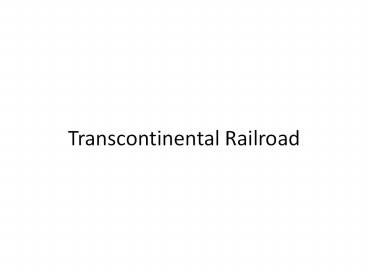Transcontinental Railroad - PowerPoint PPT Presentation
1 / 18
Title:
Transcontinental Railroad
Description:
Pioneers The Great Plains are located in the middle of America. The government wanted pioneers or settlers to move into the area and farm it. – PowerPoint PPT presentation
Number of Views:166
Avg rating:3.0/5.0
Title: Transcontinental Railroad
1
Transcontinental Railroad
2
There was no easy way for information to get out
west. First there was the Pony Express which
only took 10 days to get information from
Missouri to California. Then came the telegraph
which sent messages along wires using
electricity. Samuel Morse developed a code to
use with the telegraph called Morse Code.
3
Many people believed the best way to link the
East and West would be to build a
transcontinental railroad, a railroad across the
continent. Two companies were hired to build the
railroad Union Pacific and Central Pacific.
4
Finally, the transcontinental railroad was
completed connecting the East and West. Union
Pacific and Central Pacific meet at Promontory
Point in the Utah Territory, by the Great Salt
Lake. A golden spike was driven into the
railroad signaling that the railroad was
completed.
5
Pioneers
6
The Great Plains are located in the middle of
America. The government wanted pioneers or
settlers to move into the area and farm it. To
encourage people to move to the Great Plains,
President Lincoln signed the Homestead Act. This
law offered free land to American citizens and
immigrants who were willing to farm the land.
7
Settlers who claimed land through the Homestead
Act were called homesteaders. Before farmers
could farm the land they had to rip out the
grass. This was not easy, because the farmers
had to break through the sod, Great Plain farmers
became known as sodbusters.
8
Calling themselves exodusters, thousands of
African American pioneers started new lives on
the Great Plains.
9
Conflict on the Planes
10
As setters began moving to the Great Plains and
conflict began to rise with the Native Americans.
Lakota, Cheyenne, and Crow began to see their
traditional way of life be threatened. Battles
between these tribes and settlers began to become
more common.
11
The government was determined to support the
settlers. They wanted to region to be open for
railroad lines, farms, ranches, and new towns.
12
The government offered goods and money to Native
Americans for their land. However, Native
Americans, such as Sitting Bull, did not value
these items.
13
The government decided that Native Americans
should be moved to reservations. The government
was ready to use military force to move the
Native Americans.
14
Many tribes realized that they could not defeat
the US Army and signed treaties and moved onto
reservations. One tribe, Lakota, was moved onto
a large reservation in the Black Hills, in South
Dakota.
15
However, gold was soon discovered in the Black
Hills and miners illegally rushed onto the Lakota
reservation.Now the government was hoping to buy
the Black Hills form the Lakota.The Lakota
leader, Sitting Bull, refused to sell the land
and move again.
16
The government sent the 7th Carvery lead by
George Custer to remove Sitting Bull and the
Lakota tribe. Sitting Bull and the Lakota
tribe was camped on the banks of the Little
Bighorn River with Crazy Horse and many Cheyenne
fighters.
17
Custer saw that the US Army was badly
outnumbered, but decided to attack anyway. The
Lakota grabbed their guns and the Battle of
Little Bighorn begun.
18
Crazy Horse helped lead to Lakota to
victory.This victory was the biggest victory
Native Americans ever had over the US Army. This
victory also led to the end of freedom for Native
Americans of the Great Plains.































![get [PDF] DOWNLOAD Nothing Like It in the World: The Men Who Built the PowerPoint PPT Presentation](https://s3.amazonaws.com/images.powershow.com/10136514.th0.jpg?_=20240923062)